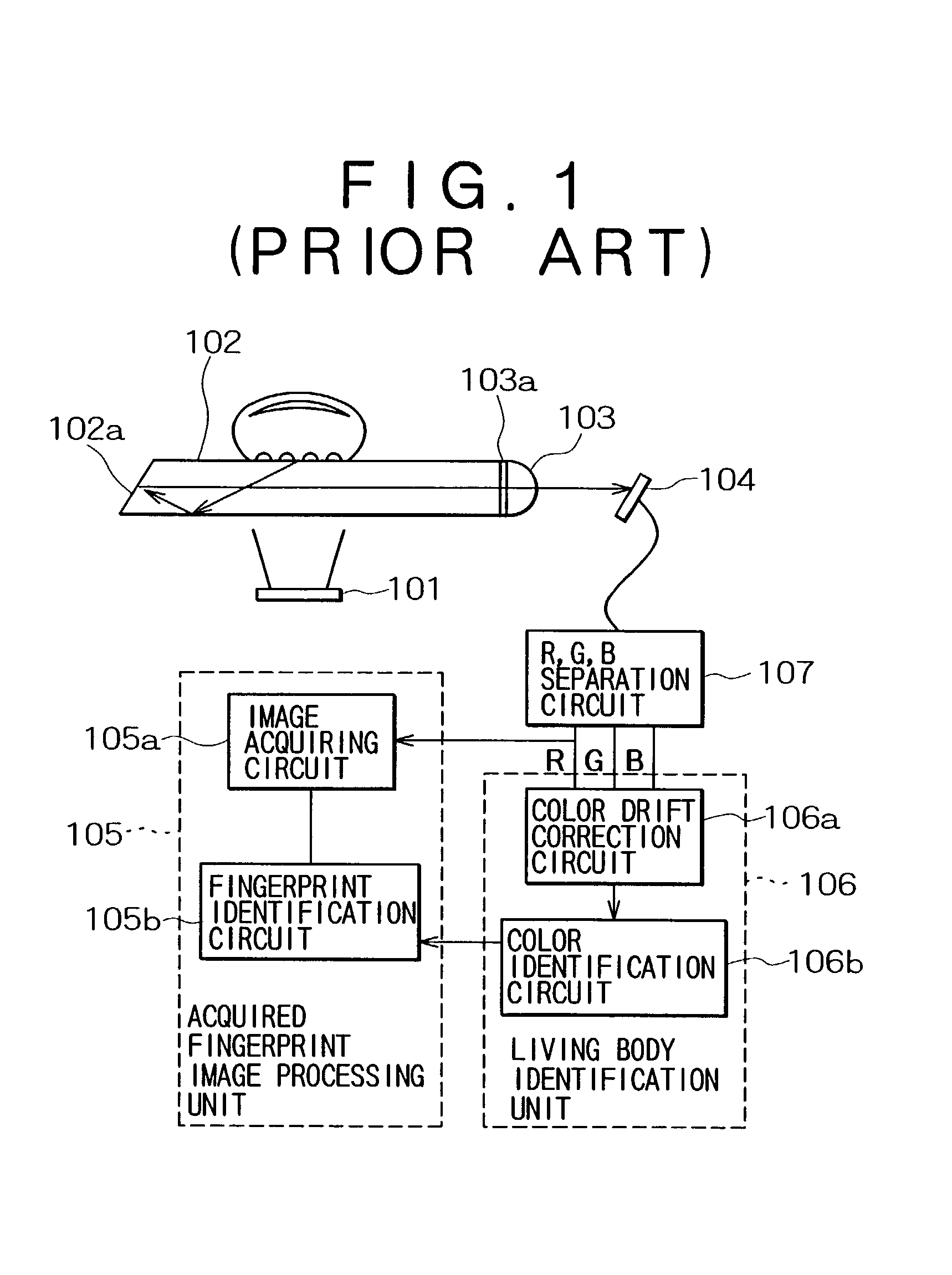Fingerprint image input device and living body identification method using fingerprint image
a fingerprint image and input device technology, applied in the direction of testing/monitoring control systems, instruments, program control, etc., can solve the problem of difficult to identify living bodies with high reliability, the device makes the wrong decision that the live finger is dead, and the unauthorized access to computers
- Summary
- Abstract
- Description
- Claims
- Application Information
AI Technical Summary
Benefits of technology
Problems solved by technology
Method used
Image
Examples
second embodiment
[0064] It should be noted that the characteristics shown in FIGS. 7 and 8 change greatly with the characteristics of the color image sensor, 10. Since the curves in FIG. 7 considerably depend on the characteristics of the employed color image sensor, the criterion for determining whether the finger is a live or dead one should be established on the basis of the correlations obtained in FIG. 8. This point will be explained in a second embodiment with reference to a few specific examples.
[0065] In summary, according to the present invention, the areal and color information is extracted from a plurality of images sequentially acquired since the finger is placed on the sensor surface, and the correlation between the areal information and the color information is used for determining whether the finger is a live or dead one. Thus compared with the prior art fingerprint image input device that distinguishes between a live finger and a dead one based on the colors of two fingerprint images...
sixth embodiment
[0078] FIG. 11 is a diagram illustrating the configuration of the present invention. This fingerprint image input device includes a color image sensor 10d, a focusing optical system 11d, a prism 12d, a light source 13d, an image temporary storage unit 20, an areal information extraction unit 30, a color information extracting unit 40, an image storage unit 50, a living body identification unit 60 and a fingerprint identification unit 70.
[0079] The constituent elements of the same functions have the same numerals in FIG. 2 and FIG. 11. What is featured in FIG. 11 is that the color fingerprint image acquiring unit uses the color image sensor 10d, the focusing optical system lid, the prism 12d and the light source 13d. Specifically, the color image sensor 10d may be a color CCD, the focusing optical system lid may be a lens, and the light source 13d may be a white light emitting diode.
[0080] In this configuration that takes advantage of the total internal reflection of light, high cont...
first embodiment
[0087] Third, in the configuration shown in FIG. 2 of the first embodiment, only necessary image data is sent from the image temporary storage unit to the image storage unit. Thus it is not necessary to store all the fingerprint images. As a result, it is possible to prevent the growth of circuit scale for analyzing the series of fingerprint images and to prevent a rise in manufacturing cost.
[0088] While the present invention has been described in some preferred embodiments, it will be apparent to those skilled in the art that the disclosed invention may be modified in numerous ways and may assume many embodiments within the scope of the invention.
[0089] As described so far, the fingerprint image input device and fingerprint-based living body identification method of the invention acquire a plurality of fingerprint images by depressing a finger onto the detector surface and detecting the finger color in synchronization with the acquisition of fingerprint images as well as detecting ...
PUM
 Login to View More
Login to View More Abstract
Description
Claims
Application Information
 Login to View More
Login to View More - R&D
- Intellectual Property
- Life Sciences
- Materials
- Tech Scout
- Unparalleled Data Quality
- Higher Quality Content
- 60% Fewer Hallucinations
Browse by: Latest US Patents, China's latest patents, Technical Efficacy Thesaurus, Application Domain, Technology Topic, Popular Technical Reports.
© 2025 PatSnap. All rights reserved.Legal|Privacy policy|Modern Slavery Act Transparency Statement|Sitemap|About US| Contact US: help@patsnap.com



